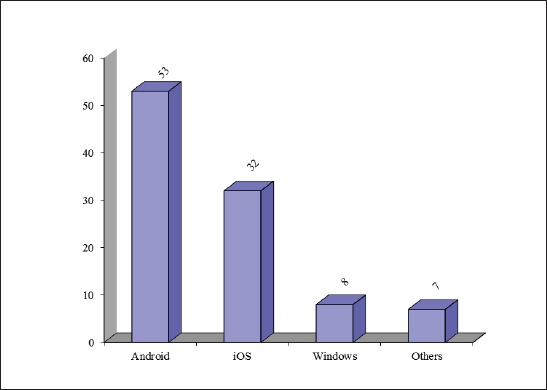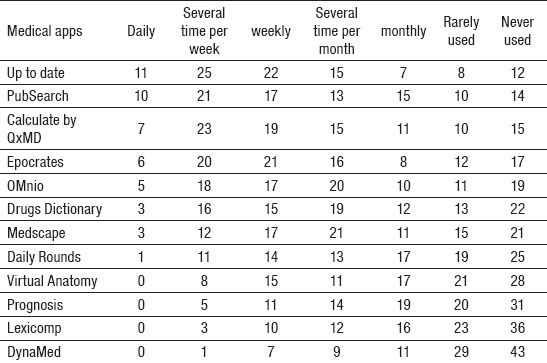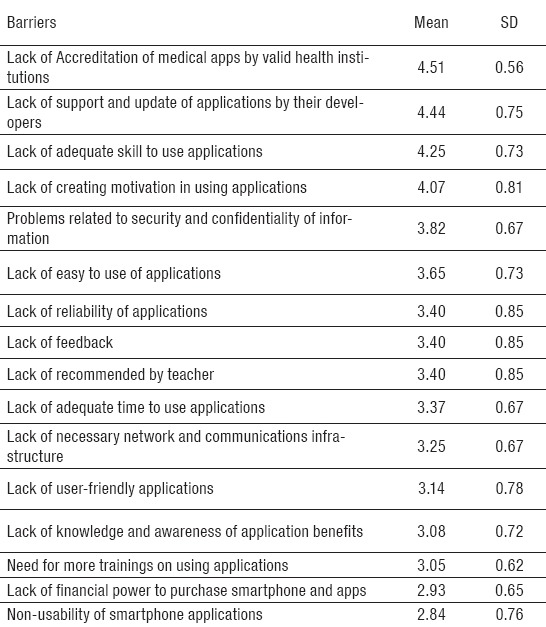Abstract
Introduction:
Medical knowledge is rapidly expanding and updating. It is very important that students can timely access to information and the latest scientific evidence without any time and place limitation. The smartphone is one of ICT tools that adopted greatly by healthcare professionals. Today, the most medical sciences universities have provided smartphone as an educational aid tool and acquisition licenses for medical apps resources in training of their students.
Aim:
This research was conducted to determine common smartphone applications among medical students of Urmia University of medical sciences and to identify barriers in using them.
Materials and Methods:
This research was a descriptive type of study carried out in 2016. Population of the study included 530 medical students completing the clinical course in Urmia University of Medical Sciences. Data were collected using researcher-developed questionnaire. The validity of it determined based on the view of experts and the reliability of it obtained by calculating the value of Cronbach’s alpha (α = 0.82).
Results:
82.3% of the students had smartphone, which in terms of operating system the highest was related Andriod (53%) and iPhone (32%). The most common applications used often by medical students included Up to date, PubSearch, Calculate by QxMD, Epocrates and OMnio. Lack of accreditation of medical apps by valid health institutions (4.63), lack of support and update of applications by their developers (4.44), lack of adequate skill to use applications (4.25) are the most important barriers in using these applications among students.
Conclusion:
To assurance quality of medical apps, it seems very important that academic and healthcare organizations should be involved to develop and update the apps and also provided guidelines for accreditation of apps. It is recommended that for promotion of knowledge and skill of students provide essential educations.
Keywords: smartphone, applications, medical students, barriers
1. INTRODUCTION
Medical knowledge is rapidly expanding and updating (1). Medical education faces many challenges in training for students with complex healthcare services process (2, 3). It is very important that teachers and students can quick and timely access to information such as clinical guidelines, drug resources, clinical calculations, and latest scientific evidence, without any time and place limitation (4-6). Thus, to meet these needs in, using information and communication technology seems to be necessary (3). Smartphone one of these tools used increasingly in recent years and adopted greatly by health specialists, especially among medical students (7). In fact, smartphone is a tool that has an operating system and it can install various applications. In addition, it has capable of integrating many technological functions into one device (5, 8). Growth and expansion using mobile and its influence in education area establish a new concept known as a mobile-based education (7-9). In consideration of smartphone potential capacities, such as mobility, feasibility, quick connection to the internet, and low price and popularity, get used to smartphone create outstanding opportunities to promote clinical communication, access to a lot of learning resources (8-10). It can be providing an education program that is proper to the students‘ needs and also lifelong learning for great number of staffs at a lower cost and independent of time and place (11, 12). The unique features of smartphone make it good candidates as learning aid tool and the penetration rate is rising rapidly in medical students (13).
Today, the most medical sciences universities have provided smartphone as an educational aid tool and acquisition licenses for medical apps resources in training of their students (5,14, 15).
Researches indicate that medical applications allow health care providers to do evidence-based practice at the care point (14-16). In a study carried out in the UK found that most of the medical students use medical smartphone apps for self-learning in a clinical environment which an overall positive effect on knowledge and skills of them (17). Conducted studies indicate that smartphone applications were using for timely access to clinical practice guidelines, making differential diagnoses, and calculation medicine dosages and available to evidence-based medical practice. Hence the effective use of this new technology help to improve diagnosis, treatment, patient care, and decline medical errors, cost and time healthcare services (15-18). The grown trend for using smartphone and popularity of medical apps among health care providers led to smartphone companies invest health apps class (8). In this regard, health apps have been developed based on the main and necessary needs in different levels of health care delivery including diagnosis of disease, drug resources, medical calculations, search of resources, clinical communications, and medical education to be used by various groups of specialists, students, and patients (5). Given the potential capabilities of smartphone technology and students’ wonderful interest to use medical apps, this research was conducted to determine common smartphone applications among medical students of Urmia University of medical sciences and to identify barriers in using them.
2. MATERIALS AND METHODS
This study is a cross-sectional descriptive study conducted in 2016. The population of the study included 530 medical students completing clinical education courses (including 210 externs, 120 interns, and 200 residents) in educational centers of Urmia University of Medical. Data were collected through a researcher-developed questionnaire and by referring to the centers. The first part of the questionnaire involves demographic information of the students, including the gender, age, and clinical education course. The second part of the questionnaire also concerns with the characteristics of smartphone and the way of familiarizing and preparing medical applications. The third part of the questionnaire determines common medical apps often used by students. The last part, barriers of using smartphone medical applications identify through five-point Likert scale. The validity of questionnaire determined based on the view of experts (including health information management, medical informatics, and medical education specialists). The reliability of the questionnaire estimated by calculating internal correlation that Cronbach’s alpha was obtained 0.84. Data analyzed using SPSS statistical software.
3. RESULTS
Almost 73% of distributed questionnaires collected (385 from 530). The more than half (53.7%) of the respondents were female, and the mean was 25.6 years. The frequency of respondents in terms of different educational courses included: 23.7% of them were residents, 36.5% were interns, and 39.8% were externs. Based on the findings, 82.3% of the students had smartphone, which in terms of operating system the highest was related Andriod (53%) and iOS (32%) (Figure 1). The methods of recognizing smartphone medical apps by students were through classmate (38.3%), App Store or Google Play (27.8%), advertisement (12.6%), teacher (10.8%) and others (10.5%). In addition, the way of preparing these applications included free downloading (45.5%), receiving through friends (20.8%), trial downloading (14.3%), software purchasing (6.8%), among basic mobile applications (4.4%), and others (9.2%) (Figure 1).
Figure 1.

Frequency percentage of smartphone operating system
Findings of the study indicated that common applications used often by medical students included Up to date, PubSearch, Calculate by QxMD, Epocrates and OMnio (Table 1).
Table 1.
Frequency percentage of using common smartphone medical applications used by students

The most important barriers in using applications from the point of view of respondents included: lack of accreditation of medical apps by valid health institutions (4.63), lack of support and update of applications by their developers (4.44), lack of adequate skill to use applications (4.25), lack of creating motivation in using applications (4.07), problems related to security and confidentiality of information (3.82), and lack of easily using of applications (3.65). (Table 2).
Table 2.
The main barriers in using smartphone medical applications

4. DISCUSSION
The healthcare professionals required to find the best evidence for providing services. Considering the advent of smartphone and its potential capabilities, using it can play pivotal role in coping with such challenges (5-8). Findings of the study performed by Farrell and Rose (2008) indicated that using mobile for nursing education in the clinical environment enhances skills of students in critical thinking and decision making, and students are preparing for patient care (19). The result of study Robinson et al (2012) showed that 59% of students had smartphones which 38% of them had operating system of iPhone, 31% BlackBerry and 21% of Andriod (11). In another study conducted by Franco et al (2012), it was found that more than 85% of respondents use smartphones that the most common operating systems were iPhone (48%) and Andriod (19%), respectively (20). The research of Gavali et al (2017) showed that Among the study population, 96% owned a smartphone which Android based 72.4%, iphone 13%, Windows based Nokia phones 7% and Blackberry 3.6%. In the our study, 82.3% of the students had smartphone, which in terms of operating system the highest was related Andriod (53%) and iPhone (32%).
Gavali et al showed that the most widely used medical applications by Indian students are Medical Dictionary, Medscape, Google/Wikipedia, Anatomy study and for Diagnosis/Prognosis in clinical management of patients (13). Franco study showed that the Epocrates, Medscape and Medcalc, respectively were most common apps (20). The research of Yadalla and Shankar showed that the common medical apps used by medical students are: MedCalc, Drug Infusion, Flashcards, Encylcopedia, Merck manual, Medscape, PubMed, Epocrates, MedlinePlus, Lab test applications, Medical dictionary and Eponyms (21). Robinson T et al showed that Medscape (19%), Oxford Handbook of clinical Medicine (14%) and British National Formularly (10%) were amongst those most favored (11). Koh Kc et al showed that the top most popular medical apps downloaded were Medscape (89.1%), Skyscape (44.5%), DynaMed (37.8%), Oxford Clinical Handbooks (28.6%), Micromedex (24.4%), Gray’s Anatomy (22.7%) and Epocrates (16.8%) (22). In study conducted by Chatterley T et al 77.4% were accessing drug references; 49.1% clinical textbooks and 22% used it for Medical dictionary (23). Findings of our study revealed that the common applications used often by medical students included Up to date, PubSearch, Calculate by QxMD, Epocrates and OMnio. Thus, the pattern of use in our research is different as compared to those in other researches.
Buijink et al (2013) mentioned the most healthcare professionals used medical apps for professional reasons, but there were barriers such as Lack of healthcare providers’ involvement in develop of medical apps, lack of quality and safety of medical apps, security and privacy of patient information, (24). Findings of study conducted by Parker et al (2013) showed that the most important barriers in using mobile mealth by the patients included concern about inadequate performance, lack of familiarity with mHealth, lack of easily use of it, additional costs, and privacy issues (25). Although numerous studies have shown widely utilization and advantages of smartphone applications in clinical practice and education such as availability of necessary hardware and mobile applications and saving time in daily work (26-28), findings of this study revealed that the most important barriers in using applications included lack of accreditation of medical apps by valid health institutions, lack of support and update of apps by their developers, problems related to security and confidentiality of information and lack of easily using of applications.
5. CONCLUSION
Considering the lack of accreditation and updating of medical apps to assurance quality of medical apps, it seems very important that academic and healthcare organizations should be involved to develop and update the apps and also provided guidelines for accreditation of apps.
On the other hand, for promotion of knowledge and skill of students in using medical apps, it is recommended that essential educations provide to use properly these apps. It is also necessary that highlighted the role of using medical apps in the improvement of professional competencies of the future job, to encourage students to utilize of these apps.
Acknowledgements
We would like to thank Urmia University of Medical Sciences, Urmia-Iran, for its support and also those participants in this study who carefully responded to our research questionnaire.
Footnotes
• Conflict of interest: The authors declared no potential conflicts of interest with respect to the research, authorship, and/or publication of this article.
• Authors contributions: Mohamad Jebraeily and Bahlol Rahimi were the responsible for the study design, data analysis, interpretation of results, and drafting the manuscript. Zahra Zare Fazlollahi contributed to the data analysis and revision of the manuscript.
• All authors read and approved the final manuscript.
REFERENCES
- 1.Schuwirth LW, van der Vleuten CP. Medical education: Challenges for educationalists. British Medical Journal. 2006;333(7567):544. doi: 10.1136/bmj.38952.701875.94. [DOI] [PMC free article] [PubMed] [Google Scholar]
- 2.Baldwin LP, Low PH, Picton C, Young T. The use of mobile devices for information sharing in a technology-supported model of care in AE. Int J Electron Healthc. 2006;3:90–106. doi: 10.1504/IJEH.2007.011482. [DOI] [PubMed] [Google Scholar]
- 3.Jones SS, Rudin RS, Perry T, Shekelle PG. Health information technology: an updated systematic review with a focus on meaningful use. Annals of internal medicine. 2014;160(1):48–54. doi: 10.7326/M13-1531. [DOI] [PubMed] [Google Scholar]
- 4.Ruskin KJ. Mobile technologies for teaching and learning. International anesthesiology clinics. 2010;48(3):53–60. doi: 10.1097/AIA.0b013e3181e5c1a1. [DOI] [PubMed] [Google Scholar]
- 5.Mosa AS, Yoo I, Sheets L. A systematic review of healthcare applications for smartphones. BMC medical informatics and decision making. 2012;12(1):67. doi: 10.1186/1472-6947-12-67. [DOI] [PMC free article] [PubMed] [Google Scholar]
- 6.Boruff JT, Storie D. Mobile devices in medicine: a survey of how medical students, residents, and faculty use smartphones and other mobile devices to find information. Journal of the Medical Library Association: JMLA. 2014;102(1):22. doi: 10.3163/1536-5050.102.1.006. [DOI] [PMC free article] [PubMed] [Google Scholar]
- 7.Ventola CL. Mobile devices and apps for health care professionals: uses and benefits. Pharmacy and Therapeutics. 2014;39(5):356. [PMC free article] [PubMed] [Google Scholar]
- 8.Safdari R, Jebraeily M, Rahimi B, Doulani A. Smartphone medical applications use in the clinical training of medical students of UMSU and its influencing factors. European Journal of Experimental Biology. 2014;4(1):633–7. [Google Scholar]
- 9.Wu WH, Wu YC, Chen CY, Kao HY, Lin CH, Huang SH. Review of trends from mobile learning studies: A meta-analysis. Computers & Education. 2012;59(2):817–27. [Google Scholar]
- 10.Ozdalga E, Ozdalga A, Ahuja N. The smartphone in medicine: a review of current and potential use among physicians and students. Journal of medical Internet research. 2012 Sep;14(5) doi: 10.2196/jmir.1994. [DOI] [PMC free article] [PubMed] [Google Scholar]
- 11.Robinson T, Cronin T, Ibrahim H, Jinks M, Molitor T, Newman J, et al. Smartphone use and acceptability among clinical medical students: a questionnaire-based study. J Med Syst. 2013;37(3):9936. doi: 10.1007/s10916-013-9936-5. [DOI] [PubMed] [Google Scholar]
- 12.Şad SN, Göktaş Ö. Preservice teachers'perceptions about using mobile phones and laptops in education as mobile learning tools. British Journal of Educational Technology. 2014 Jul 1;45(4):606–18. [Google Scholar]
- 13.Gavali My, Khismatrao Ds, Gavali Yv, Patil K. Smartphone, the New Learning Aid amongst Medical Students. Journal of Clinical & Diagnostic Research. 2017;11(5):JC05–JC08. doi: 10.7860/JCDR/2017/20948.9826. [DOI] [PMC free article] [PubMed] [Google Scholar]
- 14.Rung A, Warnke F, Mattheos N. Investigating the use of smartphones for learning purposes by australian dental students. JMIR mHealth and uHealth. 2014;2(2):e20. doi: 10.2196/mhealth.3120. [DOI] [PMC free article] [PubMed] [Google Scholar]
- 15.Vinay KV, Vishal K. Smartphone applications for medical students and professionals. Nitte University. Journal of Health Sciences. 2013;3(1):59–62. [Google Scholar]
- 16.Murfin M. Know your apps: an evidence-based approach to evaluation of mobile clinical applications. The Journal of Physician Assistant Education. 2013;24(3):38–40. doi: 10.1097/01367895-201324030-00008. [DOI] [PubMed] [Google Scholar]
- 17.Payne KF, Wharrad H, Watts K. Smartphone and medical related App use among medical students and junior doctors in the United Kingdom (UK): a regional survey. BMC medical informatics and decision making. 2012;12(1):121. doi: 10.1186/1472-6947-12-121. [DOI] [PMC free article] [PubMed] [Google Scholar]
- 18.Varshney U. Mobile health: Four emerging themes of research. Decision Support Systems. 2014;66:20–35. [Google Scholar]
- 19.Farrell MJ, Rose L. Use of mobile handheld computers in clinical nursing education. Journal of Nursing Education. 2008 Jan 1;47(1):13–9. doi: 10.3928/01484834-20080101-03. [DOI] [PubMed] [Google Scholar]
- 20.Franko O, Tirrell T. Smartphone app use among medical providers in ACGME [2] training programs. J Med Syst. 2011;36(5):3135–39. doi: 10.1007/s10916-011-9798-7. [DOI] [PubMed] [Google Scholar]
- 21.Yadalla H, Vijaya Shankar M. Professional usage of smart phone applications in medical practice. International Journal of Health & Allied Sciences. 2012;1(2):44. [Google Scholar]
- 22.Chatterley T, Chojecki D. Personal digital assistant usage among undergraduate medical students: exploring trends, barriers, and the advent of smartphones. Journal of the Medical Library Association: JMLA. 2010;98(2):157. doi: 10.3163/1536-5050.98.2.008. [DOI] [PMC free article] [PubMed] [Google Scholar]
- 23.Koh KC, Wan JK, Selvanathan S, Vivekananda C, Lee GY, Ng CT. Medical students'perceptions regarding the impact of mobile medical applications on their clinical practice. Journal of Mobile Technology in Medicine. 2014;3(1):46–53. [Google Scholar]
- 24.Buijink AW, Visser BJ, Marshall L. Medical apps for smartphones: lack of evidence undermines quality and safety. Evid Based Med. 2013;18(3):90–2. doi: 10.1136/eb-2012-100885. [DOI] [PubMed] [Google Scholar]
- 25.Parker SJ, Jessel S, Richardson JE, Reid MC. Older adults are mobile too!Identifying the barriers and facilitators to older adults'use of mHealth for pain management. BMC geriatrics. 2013 May 6;13(1):43. doi: 10.1186/1471-2318-13-43. [DOI] [PMC free article] [PubMed] [Google Scholar]
- 26.Mandzuka M, Begic E, Boskovic D, Begic Z, Masic I. Mobile Clinical Decision Support System for Acid-base Balance Diagnosis and Treatment Recommendation. Acta Inform Med. 25(2):121–5. doi: 10.5455/aim.2017.25.121-125. doi:10.5455/aim.2017.25.121-125. [DOI] [PMC free article] [PubMed] [Google Scholar]
- 27.Begic E, Mandzuka M, Begic Z, Dobraca A, Hasanbegovic E. Antihypertensive therapy dosage calculator. In: Badnjevic A, editor. CMBEBIH. Vol. 62. Springer, Singapore 2017: IFMBE Proceedings; 2017. pp. 660–65. doi:10.1007/978-981-10-4166-2_99. [Google Scholar]
- 28.Masic I, Begic E. Mobile Clinical Decision Support Systems in Our Hands - Great Potential but also a Concern. Stud Health Technol Inform. 2016;226:63–6. [PubMed] [Google Scholar]


